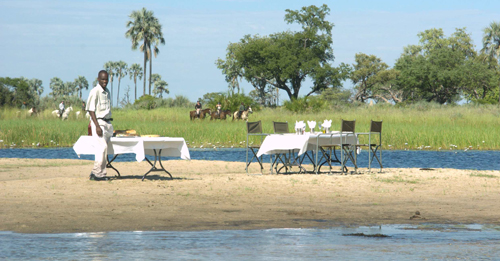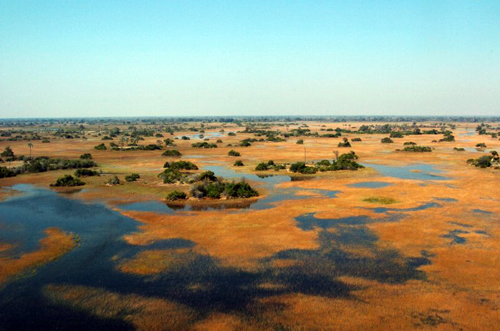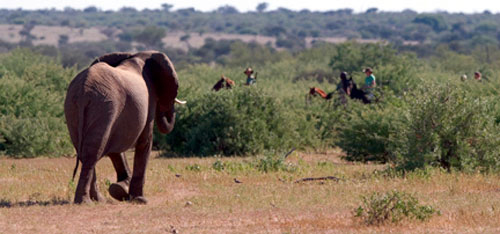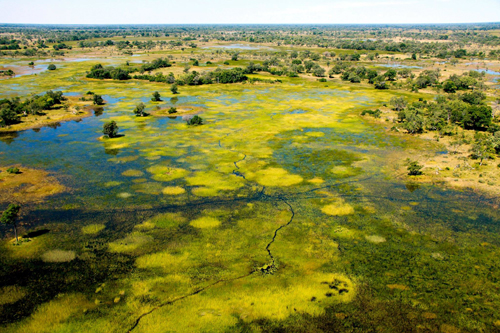|
|

|
|
|
|
Horseback riding vacations in
Botswana
Outstandingly dramatic, Botswana encompasses striking salt pans, diamond-rich deserts and fertile flood plains which teem with game. The north and south offer superb wildlife-watching opportunities, making this one of southern Africa's top equestrian horseback riding safari destinations. Hidden Trails offer three excellent Botswana horseback riding holidays – from luxury game lodges to the stunning Okavango Delta.

Horse Riding in Botswana
Great game herds still roam Botswana in tremendous numbers. The country has not been touched by the political and poaching problems which have plagued so much of the continent. Most of the incomparable animals of Africa can be seen here. Prepare to spot hippopotamus, elephant, giraffe, zebra, antelope, impala, cape buffalo, hyena, and over six hundred different types of birds. Botswana is a country the size of Kenya with only five percent of the population and a prosperous economy.
Botswana is home to the Okavango River, the third largest in Africa. The Okavango rises in Angola and empties into the Kalahari Desert, contributing to the amazing and prolific Okavango Delta wildlife sanctuary. In the south you find the wild and undiscovered Mashatu Wilderness with its large herds of elephants - the perfect place to canter with zebras or wildebeest. We offer one horse riding safaris here – the Tuli Riding Safari .

The Okavango Delta: Africa's Last Frontier
The Okavango Delta is one of the world’s largest inland water systems. Its headwaters start in Angola’s western highlands, with numerous tributaries joining to form the Cubango river, which then flows through Namibia (called the Kavango) and finally enters Botswana, where it is then called the Okavango.
Millions of years ago the Okavango River used to flow into a large inland lake called Lake Makgadikgadi (now Makgadikgadi Pans).
Tectonic activity and faulting interrupted the flow of the river causing it to backup and form what is now the Okavango delta. This has created a unique system of water ways that now supports a vast array of animal and plant life that would have otherwise been a dry Kalahari savanna.
The delta’s floods are fed from the Angolan rains, which start in October and finish sometime in April. The floods only cross the border between Botswana and Namibia in December and will only reach the bottom end of the delta (Maun) sometime in July,
Taking almost nine months from the source to the bottom. This slow meandering pace of the flood is due to the lack of drop in elevation, which drops a little more than 60 meters over a distance of 450 kilometers. The delta’s water dead ends in the Kalahari – via the Botetle river, with over 95 per cent of the water eventually evaporating.
The delta environment has large numbers of animal populations that are otherwise rare, such as crocodile, red lechwe, sitatunga, elephant, wild dogs, buffalo, wattled crane as well as the other more common mammals and bird life.
The best time for game viewing in the delta is during the May-October period, as the animal life is concentrated along the flooded areas and the vegetation has dried out. The best time for birding and vegetation is during the rainy season (Nov.- April) as the migrant bird populations are returning and the plants are flowering and green.
In only a few days it is possible to spot 100 to 200 different types of birds. After the rainy season, when the delta is flooded, you will horseback ride across river channels from island to island. In the drier areas around the flood plain there are some good opportunities for trots and canters. Your hosts are exceptionally accommodating and knowledgeable. You will stay at very comfortable British-style safari camps and begin each day with a sunrise ride to the animals' favorite resting places. Botswana is one of the few remaining destinations in Africa that still provides a good sense of the adventure of safari. Its expansive game parks and preserves combined with wildlife as diverse and abundant as that found anywhere else, are still largely undeveloped and untamed.

Mashatu Game Reserve
The remote far eastern corner of Botswana, at the confluence of the Limpopo and Shashe rivers, is historically known as the Tuli Block. It forms a diverse wilderness of savannah, riverine forests, marshland, open plains and sandstone outcrops. Located in the north-eastern Tuli Block, Mashatu Game Reserve - historically known as the Tuli enclave - is the largest privately owned game reserve in southern Africa covering an expanse of 75,000 acres. Mopane veld and open acacia savannah stretch southwards to the thick riverine vegetation of the mighty Limpopo River.
The name is derived from the magnificent Mashatu trees, which occur throughout this immense tract of privately owned land. Two of Africa's giants are found here: massive time-worn baobab trees stud the plains where huge herds of elephant roam. Indeed, Mashatu provides a refuge for the largest single population of elephant on privately owned land in Africa. Known as the relic herds of Shashe, these elephants are the last living testament to the great herds that once populated the meandering Limpopo Valley. Today, the population on Mashatu Game Reserve alone is estimated to number in excess of 500.
Mashatu is also home to prides of lion and cheetah. Along the river courses, huge Mashatu trees provide shade for eland, impala, wildebeest, giraffe and zebra. As night falls, the bat-eared fox, African wildcat and magnificent leopard search for prey. Some 366 species of birds may be seen.
This area of history and legend is a place of exceptional beauty where one can enjoy guided explorations of the rugged, unspoilt African landscape on horseback.
In addition to the game experience, Mashatu offers a view of Africa unchanged since the days of early visitors such as Kipling, Selous and artist/explorer Sir Thomas Baines. Interwoven with this natural tapestry are reminders of man's presence in ancient times. In the north-eastern part of Mashatu, black eagles nest at the Motloutse Ruins, the remains of an ancient civilisation thought to be connected to the dynasty of Monomatapa.
Explore more Southern Africa Horse Riding Holidays
|
|
Holidays on horseback in Botswana
See Mini Country Guide
|
Below is a list of our trips in this area with video clips.
 Click on the 'watch video' icon

to view a video clip,
Land of the Giants - Tuli Riding Safari

|
Allow the noble spirit of the horse to carry you on an amazing wildlife safari journey in Botswana; listen as your hoofbeats fall in the rhythm of the Africa! This journey embraces the true definition of a safari: an expedition to observe animals in their natural habitat.
|

Trip Details
|
|
Botswana
Travel restrictions
Air travel has resumed to and from Sir Seretse Khama International Airport in Gaborone, Maun International Airport, Kasane International Airport and G. Matante International Airport in Francistown.
All land border crossings to South Africa, Zambia, Zimbabwe and Namibia are open.
As of August 28th 2022, proof of vaccination, and testing at port of entry for unvaccinated travelers is no longer required.
Measures taken by the government
Botswana exited the State of Emergency as of October 1st 2021.
As of August 28th 2022, wearing of masks is no longer required.
Testing
Same day test results are available and are widely available through private clinics such as Diagnofirm.
Antigen (rapid) tests are available at the international airports and major land border crossings. PCR tests are available for foreigners at two locations: Sir Ketumile Masire Teaching Hospital and Diagnofirm Medical Laboratories, both in Gaborone.
Teaching Hospital PCR tests are 500 BWP and results can be slower than 48-72 hours as this is the main testing facility for everyone in the country and is cheaper than Diagnofirm.
Diagnofirm offers PCR tests for 999 BWP which are available in less than 24 hours. Antigen test costs range from 150 to 500 BWP. All testing is paid for by the patient.
Test results are delivered by text message/SMS. Expect delays in messaging even if the results are completed on time.
Emergency number (related to COVID-19) while visiting the country
Individuals who demonstrate specific symptoms associated with COVID-19 should call their health care provider or the MoHW Emergency Operations line at 363-2273/2756/2757 for further instructions.
Source:
US Embassy in Botswana https://bw.usembassy.gov/covid-19-information/
Published on February 8th 2023 (checked on April 5th 2023)
For more information please visit our COVID-19 Updates page at https://www.hiddentrails.com/article/covid19update.aspx
|
|
Botswana
At A glance
Capital City: Gaborone
Land size: 566,730 sq km
Population: 2,384,246 (2022 est.)
Official language: English
Currency: Botswana Pula (P / BWP)
UNESCO properties and sites:
Source: https://www.cia.gov/the-world-factbook/countries/botswana/
Botswana's breathtaking beauty and abundant wildlife provide a unique and thrilling adventure for every traveler. Journey to the vast and remote Tuli block, home to the impressive Mashatu Game Reserve, where elephants roam freely among baobab trees. Immerse yourself in the warm hospitality of the Batswana people and experiencing their rich traditions.
Botswana is a haven for equestrian enthusiasts. Begin your journey in Maun, the gateway to the Okavango Delta, and experience the thrill of riding through the vast floodplains and winding channels of this unique UNESCO World Heritage Site. Discover the iconic Big 5 from the back of a horse, for a truly unique perspective on this lush ecosystem.
Get ready to forge unforgettable connections with nature, culture, and the soul of Africa as you ride through the wild beauty of Botswana.
Brief History
Seeking to stop the incorporation of their land into Rhodesia (Zimbabwe) or the Union of South Africa, in 1885, three tribal chiefs traveled to Great Britain and successfully lobbied the British Government to put "Bechuanaland" under UK protection. Upon independence in 1966, the British protectorate of Bechuanaland adopted the new name of Botswana.
More than five decades of uninterrupted civilian leadership, progressive social policies, and significant capital investment have created one of the most stable economies in Africa. The ruling Botswana Democratic Party has won every national election since independence.
Source: https://www.cia.gov/the-world-factbook/countries/botswana/
Cultural Insights
Batswana emphasize extensive greetings and inquiries after each other. It is polite to address senior men as Rra and women as Mma (literally, father and mother).
Grown women should keep their thighs covered, but more and more women are wearing tight pants, and short skirts are seen in urban areas.
Source: https://www.everyculture.com/Bo-Co/Botswana.html
Transportation
By Air
Most major international airlines from Europe, the United States, Asia and Australia fly to Johannesburg, South Africa, where connecting flights can be booked to Sir Seretse Khama International Airport in Gaborone, or to Maun, Francistown or Kasane.
Source: https://www.botswanatourism.co.bw/travel-info/getting-there
Money
ATMs are available in the major towns and larger villages, but most only accept Visa. Major credit cards are accepted at many shops and restaurants in towns.
In Botswana, one is not under any obligation to offer gratuity (tips) for services rendered at restaurants, bars, hotels, etc. It is at the discretion of the individual whether or not to pay gratuity for services.
Source: https://www.gov.uk/foreign-travel-advice/botswana
https://www.botswanatourism.co.bw/travel-info/general-information
Health
Health care in Botswana is good in major towns, but medical facilities and communications are limited in rural areas. For serious medical treatment, medical evacuation to the UK or South Africa may be necessary.
If you need emergency medical assistance during your trip, dial 997 and ask for an ambulance. You should contact your insurance/medical assistance company promptly if you’re referred to a medical facility for treatment.
Ambulance services are widely available but training and availability of emergency responders may be below U.S. standards.
Private hospitals will not treat patients unless you can pay, and the cost of health care may be high. Outpatients must pay cash before receiving treatment. You will only be accepted as an emergency patient if you have full insurance cover. Make sure you have adequate travel health insurance and accessible funds to cover the cost of any medical treatment abroad and repatriation.
Always carry your prescription medication in original packaging, along with your doctor’s prescription. Check with the Botswana Medicines Regulatory Authority to ensure the medication is legal in Botswana.
Avoid drinking tap water and ice made from tap water. Many restaurants and hotels serve tap water unless bottled water is specifically requested. Bottled water and beverages are generally safe to drink.
If you intend to camp or walk in the bush you should be aware of the risk of tick bites.
Source: https://www.gov.uk/foreign-travel-advice/botswana
https://travel.state.gov/content/travel/en/international-travel/International-Travel-Country-Information-Pages/Botswana.html
Electricity
Botswana operates on a 230V supply voltage and uses type D, G and M plugs.
The Type D electrical plug has three large round pins in a triangular pattern. Type M plugs are often used alongside Type D plugs for larger appliances and as a result, some sockets work with both Type D and Type M plugs.
The Type M plug has three round pins in a triangular pattern and looks similar to the Indian Type D plug, but its pins are much larger.
The Type G electrical plug has three rectangular blades in a triangular pattern and has an incorporated fuse.
Source: https://www.iec.ch/world-plugs
Communication
Time zone in Botswana: Central Africa Time (GMT+2)
International country code – 128
Effective regulatory reform has made Botswana’s telecom market one of the most liberalized in the region.
In a bid to generate new revenue streams and secure market share, the three mobile network operators have entered the underdeveloped broadband sector by adopting of 3G, LTE, and WiMAX technologies.
The landlocked country depends on satellites for international bandwidth, and on other countries for transit capacity to the landing points of international submarine cables; the landing of additional cables in the region in recent years has improved the competitive situation in this sector, while prices for connectivity have fallen dramatically. (2022)
Most of Botswana is networked by automatic telephone exchanges, with public telephones in even the most remote places. All major towns in Botswana are network-covered, as well as portions of the national highway.
The International access code in Botswana is 00. When calling international to Botswana, dial +267.
Source: https://www.cia.gov/the-world-factbook/countries/botswana/
https://www.botswanatourism.co.bw/travel-info/communications
Entry Requirements
Citizens of most European and Commonwealth countries do not require a visa for entry into Botswana. However, visitors should check with Botswana embassies or consulates before departure.
Note: For countries with whom Botswana has no diplomatic representation, visa information and processing are available through British Embassies and High Commissions.
You can find a list of countries that require a visa to enter Botswana, just below:
https://www.botswanatourism.co.bw/travel-info/countries-requiring-visas
Source: https://www.botswanatourism.co.bw/travel-info/entry-formalities
Embassies and Consulates
U.S. Embassy in Gaborone
Embassy Drive
Government Enclave
Gaborone
Phone: (+267) 395-3982
Consulate of Canada in Gabrone
9th floor, iTowers North, Lot 54368
Gaborone
Phone: (+267) 3160 926 / (+267) 3160 946
Source: for USA https://www.usembassy.gov/
For Canada: https://travel.gc.ca/assistance/embassies-consulates
UNESCO Sites
Tsodilo
With one of the highest concentrations of rock art in the world, Tsodilo has been called the ''Louvre of the Desert''. Over 4,500 paintings are preserved in an area of only 10 km2 of the Kalahari Desert. The archaeological record of the area gives a chronological account of human activities and environmental changes over at least 100,000 years. Local communities in this hostile environment respect Tsodilo as a place of worship frequented by ancestral spirits.

Okavango Delta
This delta in north-west Botswana comprises permanent marshlands and seasonally flooded plains. It is one of the very few major interior delta systems that do not flow into a sea or ocean, with a wetland system that is almost intact. One of the unique characteristics of the site is that the annual flooding from the River Okavango occurs during the dry season, with the result that the native plants and animals have synchronized their biological cycles with these seasonal rains and floods. It is an exceptional example of the interaction between climatic, hydrological and biological processes. The Okavango Delta is home to some of the world’s most endangered species of large mammal, such as the cheetah, white rhinoceros, black rhinoceros, African wild dog and lion.
Source: https://whc.unesco.org/en/statesparties/BW
|
|

|
|
|
List of Tours
![]() Mashatu Mashatu![]() Okavango Delta Okavango Delta
|